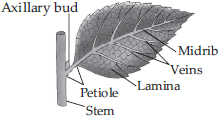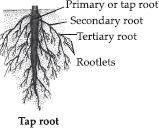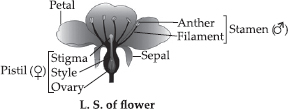Getting to Know Plants - NCERT - NCERT Questions
Correct the following statements and rewrite them in your notebook.
(A) Stem absorbs water and minerals from the soil.
(B) Leaves hold the plant upright.
(C) Roots conduct water to the leaves.
(D) The number of petals and sepals in a flower are always equal.
(E) If the sepals of a flower are joined together, its petals are also joined together.
(F) If the petals of a flower are joined together, then the pistil is joined to the petal.
(A) Roots absorb water and minerals from the soil.
(B) Stem holds the plant upright.
(C) Stem conducts water to the leaves.
(D) The number of petals and sepals in a flower are not always equal.
(E) If the sepals of a flower are joined together its not necessary that petals are also joined together. For example, in Hibiscus rosa-sinensis (China rose) sepals are joined whereas petals are free or not joined.
(F) If the petals of a flower are joined together, then the pistil may or may not be joined to the petal.
Draw (A) a leaf, (B) a tap root and (C) a flower.
SOLUTION: (A) 
(B) 
(C) 
Can you find a plant in your house or in your neighbourhood, which has a long but a weak stem? Write its name. In which category would you classify it?
SOLUTION:Money plant has a long but weak stem. Money plant is classified as a climber, i.e., the plant with weak stem that cannot stand upright and climb with the help of a support.
Q 4.What is the function of a stem in a plant?
SOLUTION: The main functions of a stem are as follows :
(i) The stem keeps the plant upright.
(ii) It bears and supports branches, leaves, flowers and fruits.
(iii) It conducts water and mineral salts from roots to the leaves and other plant parts.
(iv) The food manufactured in the leaves is transported to the roots, fruits and organs of storage through the stem.
Which of the following leaves have reticulate venation?
Wheat, Tulsi, Maize, Grass, Coriander (dhania), China rose
Leaves of tulsi, coriander (dhania) and China rose have reticulate venation whereas leaves of wheat, maize and grass have parallel venation.
Q 6.If a plant has fibrous root, what type of venation do its leaves likely to have?
SOLUTION:If a plant has fibrous root, then the leaves are most likely to have parallel venation, e.g., wheat, maize, grass, etc.
Q 7.If a plant has leaves with reticulate venation, what kind of roots will it have?
SOLUTION:If a plant has leaves with reticulate venation, then it is likely to have tap roots, e.g., tulsi, China rose.
Q 8.Is it possible for you to find out whether a plant has taproots or fibrous roots by looking at the impression of its leaf on a sheet of paper?
SOLUTION:Yes, it is possible to find out whether a plant has taproots or fibrous roots by looking at the impression of its leaf on a sheet of paper. If the impression of leaf is net-like on both sides of midrib, then the venation is reticulate and plant will have taproots. In parallel venation, the veins are parallel to one-another and such plant possesses fibrous roots.
Q 9.Write the names of the parts of a flower.
SOLUTION:The parts of a flower are sepals, petals, stamens and carpels. A stamen consists of an anther and a filament. A carpel (or pistil) consists of stigma, style and ovary.
Q 10.Which of the following plants have you seen? Of those that you have seen, which one have flowers?
Grass, maize, wheat, chilli, tomato, tulsi, peepal, shisham, banyan, mango, jamun, guava, pomegranate, papaya, banana, lemon, sugarcane, potato, groundnut.
Grass, maize, wheat, chilli, tomato, tulsi, peepal, shisham, banyan, mango, jamun, guava, pomegranate, papaya, banana, lemon, sugarcane, potato and groundnut all of them have flowers.
Q 11.Name the part of the plant which produces food. Name this process.
SOLUTION:Leaves of the plant produce food by a process known as photosynthesis.
Q 12.In which part of a flower, you are likely to find the ovary?
SOLUTION:Ovary is found in the female reproductive part, i.e., carpel or pistil of a flower.
Q 13.Name two flowers, each with joined and separate sepals.
SOLUTION:In China rose (Hibiscus rosa-sinensis) and brinjal (Solanum melongena) flowers have joined sepals. In candytuft (Iberis amara) and mustard (Brassica campestris) flowers have separated sepals.